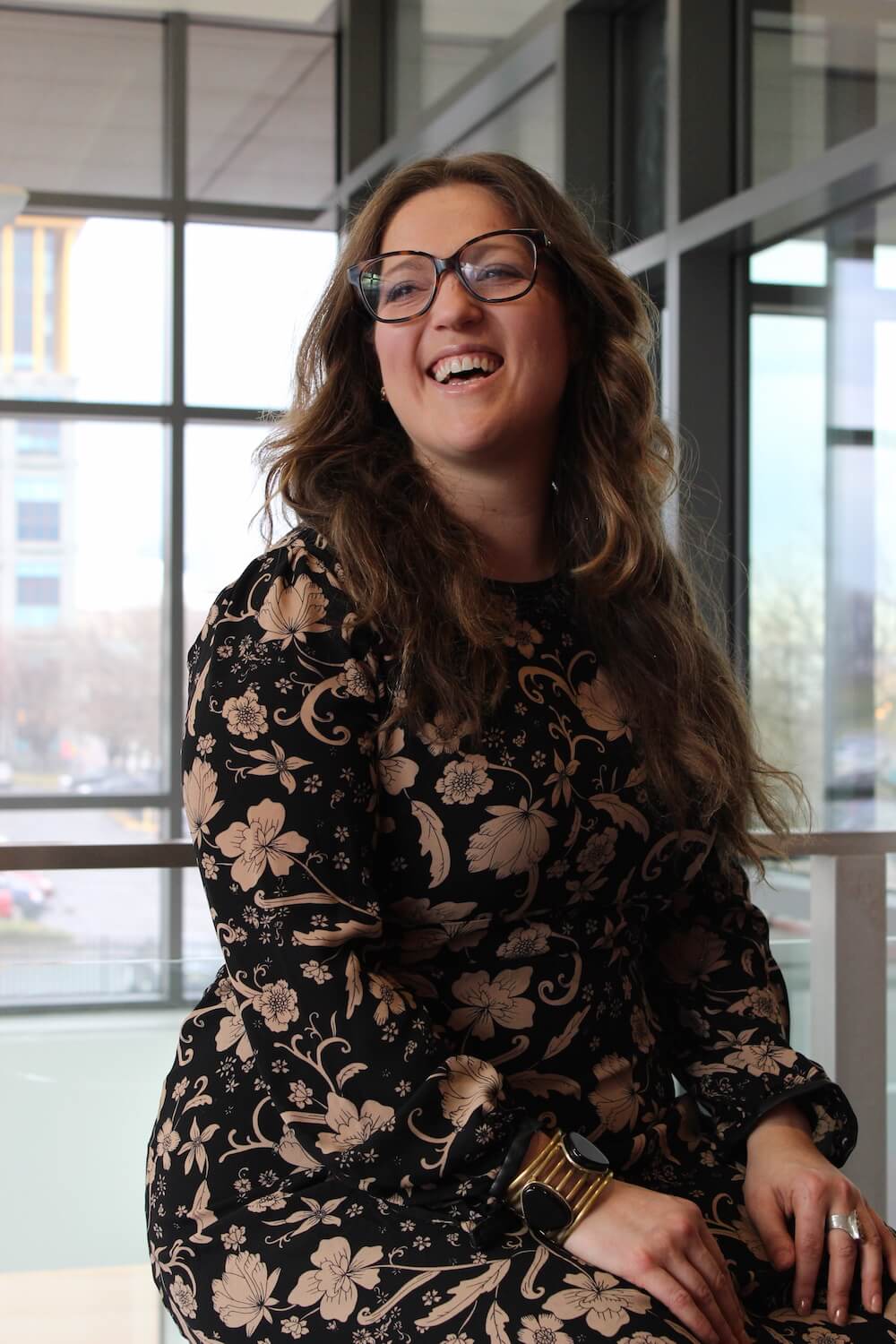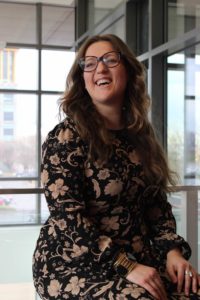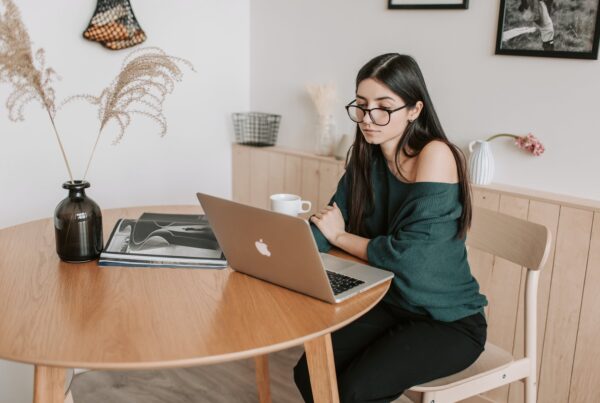
It’s December 2015. I’m burned out, exhausted.
I’ve just shut down my first company, and my dream of launching and building a business that empowers others to find work they love feels very far away.
Enter Lindsay Tabas, The Lady Engineer – Systems Engineer Turned Customer & User Experience Designer.

Through a community of trailblazing women, Dreamers & Doers, Lindsay and I were randomly set up as accountability partners. Chance would have it that Lindsay was also going through a difficult time.
By the third call, Lindsay and I had become good friends, not just because we experienced similar struggles, but because we shared the same values: creativity, freedom, compassion, challenging the status quo.
A Berkeley engineer fully immersed in the startup world, Lindsay left Silicon Valley to create a business that helps (com)passionate and people-minded startups succeed.
This week, I’m thrilled to interview Lindsay for #WorkBiggerStories.
In this interview, we talk about: (1) what it was like to try to make it as a woman in Silicon Valley and what Lindsay decided to do instead, (2) what Lindsay believes is the biggest problem with our world today, and (3) how we can be more creative with our work.
One of my favorite things about Lindsay isn’t that she’s super smart. It’s her resilience, her loyalty, and that her mission is to design technology for people so we can design ourselves into the future.
Without further ado, meet Lindsay.
Give us some background. Where are you from, and where did you start out?
I designed my first user interface in 2002 while studying Systems & Information Engineering at the University of Virginia. Ever since then, I’ve been obsessed with designing technology for people.
Those 2 sentences describing my starting point roll off my tongue in a way that might suggest my path was straight forward. It was anything BUT!
After college, I set out on a mission to be successful in Silicon Valley & the startup world. I had twinkles in my eyes when I started my first year in graduate school at UC Berkeley in 2005.
While in San Francisco, I struggled with establishing myself as a professional. I could talk database design and object oriented-programming with my developer teammates, and I could also speak to customers about the business and what they needed from software.
Sounds like a highly desirable set of skills, right? Wrong. Once, I asked if I could talk to the employees that were going to use the software I designed. Their manager said, “No. That’s not necessary. They’ll use it because it’s their job.”
That attitude lost that same company $200 million rolling wireless tablets to a workforce without collecting requirements from the workers. None of them used the tablets because they made their job harder instead of easier.
Can you share with us what challenges you’ve faced as you started out in your career?
When I started out in the Bay Area, I faced a myriad of challenges; some were hard and others easy to identify:
Mark Zuckerberg’s Harvard-dropout-status had become a thing and no one cared for my Berkeley degree.
- There didn’t seem to be as much shared care for the human element of technology design.
- The job I really wanted to do was only available at big companies like Oracle, Cisco and Salesforce (I had strong “allergies” to behemoths like these).
- I was just a spunky 24-year-old “girl” with credentials people didn’t associate with someone like me.
Like any Type A woman with a slight bout of neuroses, I blamed all of my challenges on my own choices. I didn’t enjoy software coding as much as design, and I hated myself for it. If only I coded, I could work at one of the “hot startups.”
I also couldn’t stand working for any of my bosses and felt suffocated under the rigidity of the 9-to-5. Again, I thought something was wrong with me. Why couldn’t I just treat this job like a “job.” “It’s called work for a reason, Lindsay,” my friends said to me.
I looked for any opportunity “out” that I could find. I even applied for a Fulbright scholarship and my professor told me it seemed like I just didn’t want to work. He was right. I didn’t get accepted.
In 2009, I was 25 and planning to go to the World Cup in South Africa in 2010. I wanted to take 3 weeks off and my stomach churned at the thought I’d have to ask my same boss in another year for that time. So, I figured out that I could buy an around-the-world (RTW) trip ticket all on credit card miles. I quit my job and packed my bags.
What is your mission, the work you want to do?
My mission is to increase the success rate for (com)passionate and people-minded startups. In my career, I’ve worked with 30+ startups and interfaced with over 60 investors. I also review startups on behalf of investors. I took everything that I know from the past 15 years and put it into my new 6-week program, “The Lady Engineer Shares Her Secret Advantage: A Clear Path from Today to Investor Funded Startup Growth.”
It’s specifically designed for entrepreneurs that want to build a profitable business while eliminating the guesswork normal startups encounter. Getting rid of the guesswork is as easy as making your customers your new best friends.
What led you here? Can you recall any experiences you had that pushed you to your mission?
At the very root of my mission is that I want to design technology for people, and make sure people use technology instead of technology using us. It’s imperative we all conscientiously design ourselves into the future.
And as I mentioned, I’ve been obsessed with this notion since 2002. Yet, I hadn’t allowed that passion the full space it needed to grow until the past year or two.
When I lived in Silicon Valley, I really blamed all my struggles on myself. And, so I learned over my career to dress, act and say what I needed to be successful.
It all started when I was 24, and I thought dying my hair brown would make people take me more seriously. In my late 20s, it continued; I spent thousands with career coaches to learn how to adjust my behaviors in the office to be more amenable to the team (…so I didn’t come off as a “bitch”).
The world, be it my career or my dating life, was telling me to tone everything down. At bars, guys turned on their heels when I told them I went to grad school at Berkeley and, at work, bosses laughed at me when I took the initiative to comment or ask questions because “Of course, Lindsay has something to say.”
So, when I decided to really focus on me and me as a business, I found I couldn’t come up with a brand that was authentic. I was still trying to fit into what Silicon Valley wanted from me and it was affecting my ability to grow my venture.
During one particularly rough valley in my journey, I wrote in my journal every day for an hour each morning. It was 2016, I had spent 10+ years in tech; I just let all my fears, anxieties and pain out onto the paper.
I cried as I realized how much resentment I had built up over the year towards the industry and towards my past coworkers. I was always the most technical person on the product management team but was constantly denied the deference or belittled for always weighing in with an opinion. I was pissed at all the people I had worked with that didn’t understand that designing for the customer was REALLY important. I was tired of constantly having to explain and advocate while also subjugating myself to superiors with fewer skills for the digital age.
I kept writing: I was down right mad that people all around me appeared to be suffering from poorly designed technology systems that made their jobs harder to do.
I saw that the BIGGEST PROBLEM in our world was not poverty, famine or economic disparity. Our biggest problem was that our collective intelligence was not being given the space for the creativity needed to solve all of these issues.
Clear minds are happy minds. Happy minds are creative. You cannot be creative if you’re expected to be available 24/7/365 by email and in your desk 9-to-5 Monday thru Friday. The wheel WAS NOT invented in the boardroom.
At Work Bigger, one of our goals is to build creativity among readers and community members. We know this is a key skill required to thrive in the future of work. Can you share your definition of creativity?
Creativity as a technology designer is very different than creativity as an artist. In the latter, uniqueness is celebrated; artists strive to do something totally new.
When designing software and products, creativity is about making a tool that can solve a problem. You don’t want that tool to be totally unique but to be built off of common conventions so a person can easily figure out what it does and how to use it.
What are your favorite go-to resources or experiences to help you build your creativity?
I find the biggest road block to creativity is your belief that you are not creative. And, as an engineer, I can’t talk about creativity without talking about problem-solving.
The next largest block is that people tend to get anxious when encountered with a problem so they jump very quickly to the first solution they identify. But that solution is probably the most obvious one and it may solve the most obvious problem. Therefore, it won’t be that creative and it won’t be that useful.
The reality is, there are probably 20 more factors behind that obvious problem that you need to consider. Creativity comes from really understanding the problem you’re trying to solve.
I love this Einstein quote, “It’s not that I’m so smart, it’s just that I stay with problems longer.” I encourage everyone to research the problem they’re trying to solve and talk to as many other people that experience.
I tell my entrepreneurs to marinate in the problem.
What advice do you have for 20 to 30-somethings who want to make an impact through their work but are currently feeling stuck?
“Life is difficult. This is a great truth, one of the greatest truths. It is a great truth because once we truly see this truth, we transcend it. Once we truly know that life is difficult – once we truly understand and accept it – then life is no longer difficult. Because once it is accepted, the fact that life is difficult no longer matters.” – M. Scott Peck, M.D. “The Road Less Traveled.”
Questions and comments? Check out Lindsay’s work on YouTube & learn more here.
Now, what are some insights that you’ve taken from this interview? Share with us in the comments below.



Writing these answers were initially very difficult for me. My Dad use to say to me, “Save your tears for something important.” That adage was helpful in building my resilience and letting people’s negativity or behavior not deter me from doing what I want to do. BUT it also led me to downplay situations or overly judge myself when I was upset.
I’m glad you gave me a venue to start sharing my story.
I’m grateful for our friendship and reading your intro gave me chills. I’d love to talk to any of your readers if they need help with similar situations.
Thank you so much for your comment Lindsay! It’s an honor to feature you. Your story is so powerful, and I couldn’t agree more that it’s really important not to overly judge ourselves or downplay situations that make us feel badly. So grateful for our friendship as well and thank you for your generous offer to readers!